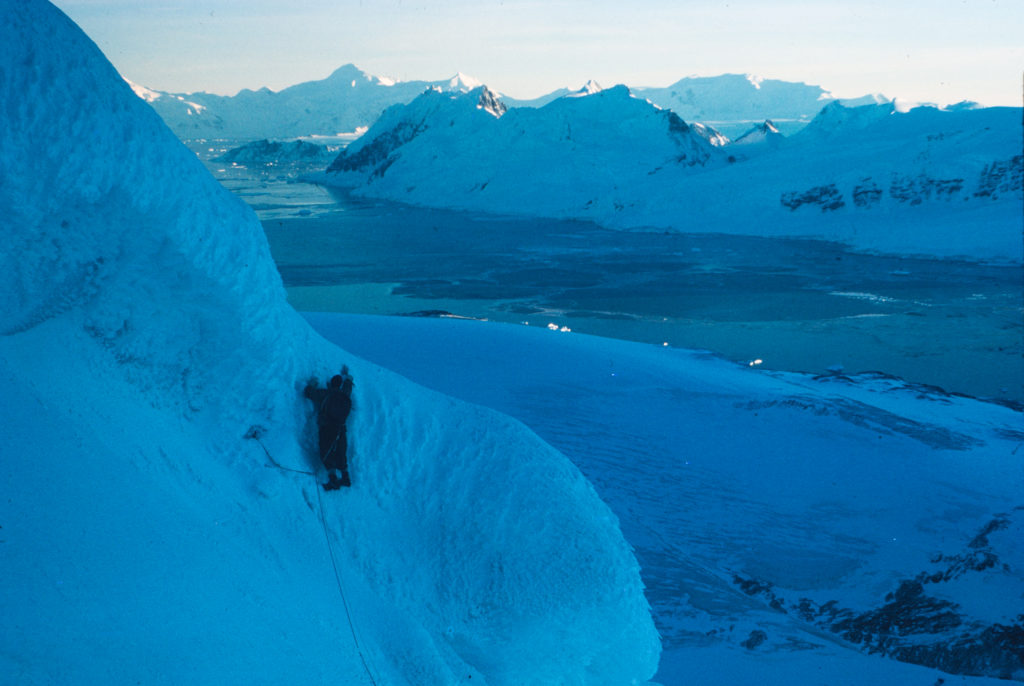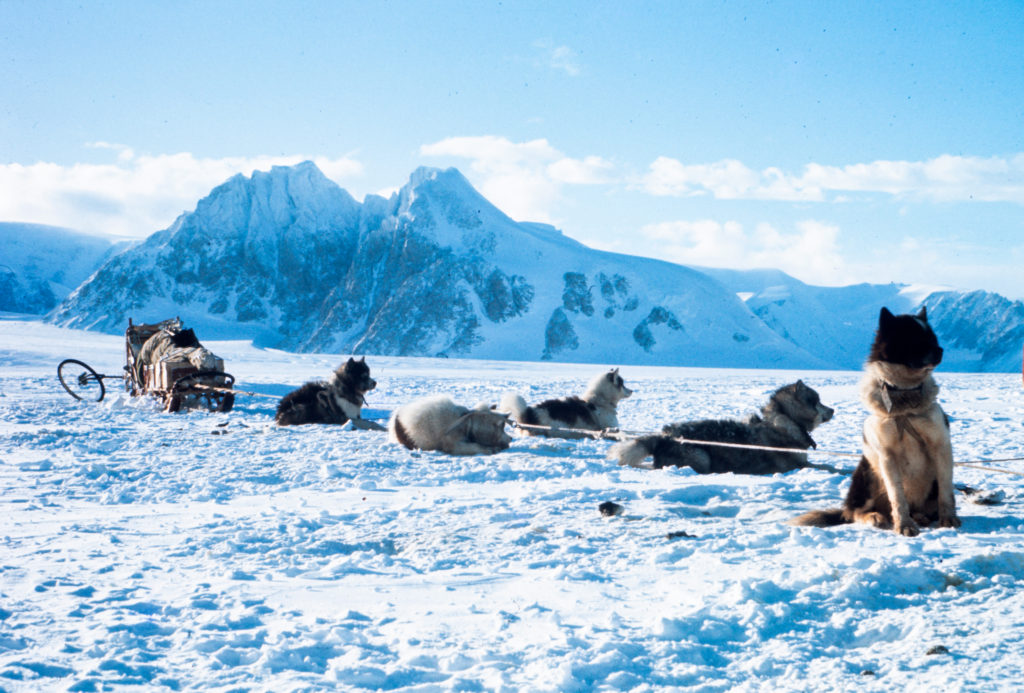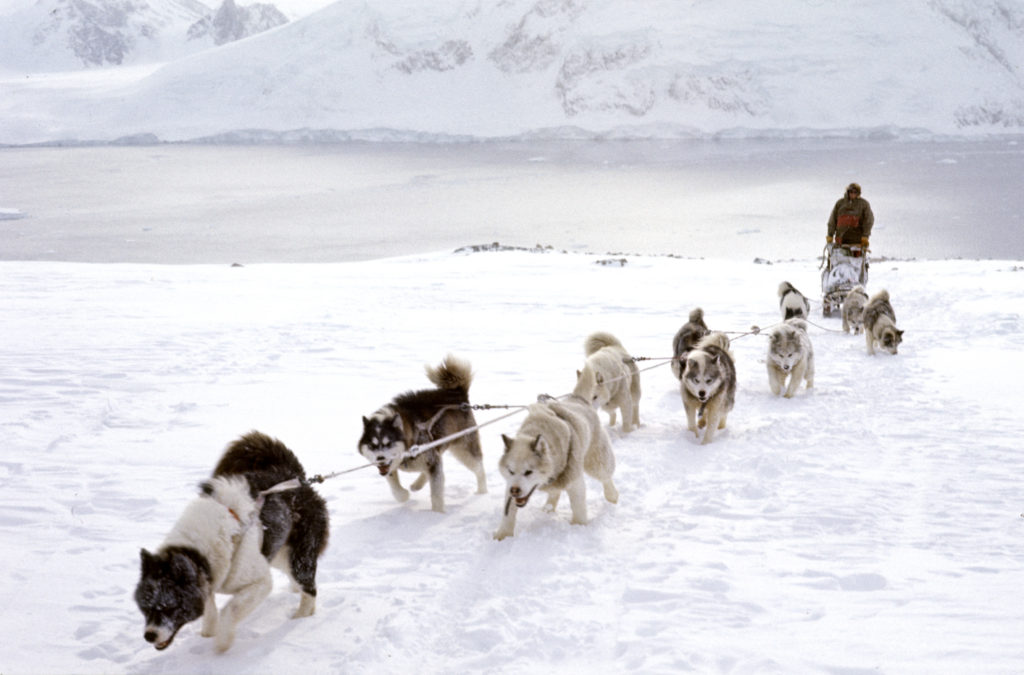Header Photo: Blaiklock Refuge by Moonlight (Photo: Malcolm McArthur)
Diary Extracts – Arrowsmith Climbs (continued)
Arrowsmith Climbs (continued)
Two hours of steady climbing, spoiled only by descending cloud which shut off any view, and our spur joined the broad summit ridge. We moved along it cautiously in decreasing visibility, suddenly exposed to the full blast of a vicious wind. We were aware of a cornice but found it difficult through mist and ice-coated specs to gauge whether we were a safe distance from the edge. Cramponing on a hard wind-crust meant there would be no track to follow in descent which was worrying. A serac loomed up and was skirted. Several holes were discovered when we put our legs into them, glad to be on a rope. The angle was easing off and it felt as if we were almost there. But we could see next to nothing and finally discretion proved the better part of valour. Reluctantly, we turned round and groped our way back the way we had come. Halfway down we dropped out of the cloud and could see the pink dot of the tent far below, the howling of the dogs carrying clearly on the wind.
Postscript
Inevitably, the weather next day was perfect, the best we have had since being dropped on the Jones Ice shelf in March. We can see that we were literally 50ft or less from the summit so we are claiming it as an ascent. On my map I’m calling it Mount Dersingham after the village in Norfolk where my folks live but I don’t suppose that BAS will adopt it.

May 15th (with Malcolm McArthur and the Spartans)
Back at the Jones’ for a spell in charge of the animal sick-bay. Seizing the opportunity of a day’s interval between our arrival and Delta’s departure, Malcolm and I today climbed the west face of the large peak on Blaiklock overlooking Scree Cove. This time we had excellent weather, making it one of the most exhilarating, worry-free day’s climbing I’ve ever had. We have been calling it Christmas Pud because of the way snow seems to dribble down it but I think I’ll put it on my map as Mount Sandringham as a sequel to Mount Dersingham.

It was still dark when we left camp but by the time we reached the col above Scree Cove, an hour and a half’s run, the sky was rose in front, saffron behind. It was after 11 by the time we had picketed the dogs and sorted out boots and gear and as we plodded up the first snow slope the sun came down it to meet us. Thereafter it was with us most of the day, only briefly obscured by the bulk of Mount Rendu, and at times we were climbing in shirtsleeves and bare hands. Our route involved straightforward if strenuous step-kicking up a long shallow couloir, on a line left of the summit, until further progress was barred by a continuous ice-cliff. Malcolm climbed a short but steep pitch on rather rotten ice to take us over a weakness in the barrier and onto the summit icefield.

The view down Scree Cove, suddenly revealed, was breathtaking, the long black arm of gleaming water directing the eye to the glowing, golden peaks of Pourquoi Pas. The icefield really was ice and brittle too as we discovered when we tried to drive a peg into it. Fortunately, it was at an angle that made front-points unnecessary but serious ground, nonetheless. Crossing it on a rising traverse we were relieved to hit soft snow and headed straight up, threading a way through a number of donglers, great cauliflowers of sugary snow and rotten ice that are a feature of the mountains down here.
The summit proved to be another of them, like the pom-pom on a ski hat, and we had to climb fifty feet of very steep, unstable snow to reach the top. It gave a final airy flourish to the climb adding to a wonderful sense of space and light all around. It was utterly still, utterly quiet. In every direction stretched mountains and glaciers, intersected by fjords in which leads of open water glinted in the dropping sun.

Far away Mount Wilcox stood out above all else, like a prominent arrowhead, still waiting to be climbed…
But time was short. It had taken us three and a half hours to climb about 3500ft. The descent, after a flurry of photos, took another hour and a half. We were back on the col to a frantic reception from the dogs as the light faded and sledged back to camp in the dark and minus twenties.
May 21st
Lying up today as the wind rose and the mist came down just as we were getting up. Yesterday Gwynn and I climbed the southern of two small peaks at the foot of the Heim’s true left bank, overlooking the Jones’. It’s going on my map as Mount Wolferton to continue the Norfolk theme.

It was very straightforward, about 2000ft of steepish snow with some hard neve at the top. Again we had fine weather, magnificent views and a sun-bathed summit. We were sweating as we kicked steps upward yet the air temperature kept our beards a mass of ice all day.
The hardest part of the climb was sledging to and from the foot of it through a belt of crevasses. When we set off for home my dogs took off with enough force to put a rocket into orbit, as they always do after a long wait. Since we were on a slope I had no hope of holding them with the brake and, unfortunately, instead of following the track in a wide arc round to the left they made straight for Gwynn’s team, already half a mile below.

As a result we thundered straight across the crevasse lines we had so carefully skirted on the way up. While I yelled desperately at the dogs and vainly tried to brake, we opened up one hole, charged across another and then, whoosh, Jet and Yuri were on the far side of a six-foot gap and the trace showed that Morag, who had been leading, was dangling somewhere below. I went forward hoping to lift her straight out but made the fatal mistake of leaving the sledge unpicketed. The other dogs panicked and before I knew what was happening dogs and sledge were careering downhill, leaving me stranded in the middle of the crevasses, forlornly clutching a single ski. I felt not a little foolish.

Patient as ever, Gwynn picketed my dogs when they reached him and drove back up with his team. It turned out that Morag’s harness had broken. I abseiled into the crevasse and found her about 60ft down on a small snowbridge, presumably the snow which had collapsed under her, with a further hundred foot drop on either side. She seemed none the worse for wear, just very pleased to see me! I attached her to a second rope, passing two loops under her stomach, and then jumared out, taking longer than I should have done. By the time I eventually re-emerged it was dark and together we hauled Morag out. Gwynn had driven his team across the crevasse further to the left where it narrowed so that his sledge could act as a bridge if we needed to set up a hoist. The problem now was to bring his dogs back to the lower side of the crevasse without pulling his sledge into it. As I led the dogs around I fell up to my armpits into another crevasse whose existence we hadn’t suspected.
Finally, however, we were once more on our way home, me leading with old Jet up front as he seemed the only dog able to follow the faint trail back to camp in pitch darkness. Troubles never come singly though and, sure enough, I had no fewer than four major punch-ups on the way. The temperatures must be in the minus thirties at night now and we were glad when the tilly lamp and primus were alight and the tent a haven of warmth. An eventful day and more than one one lesson learned the hard way!
Rob Collister – GA Stonington 1971

